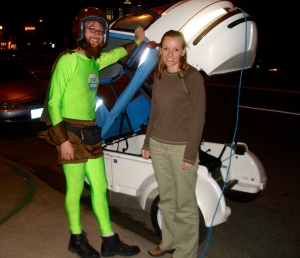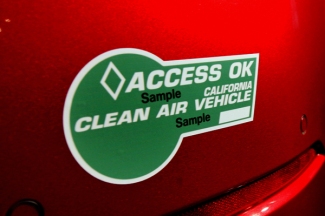The potential ending of the federal electric vehicle tax credit may become the first instance of falling footwear that EV fans have been cautiously awaiting for a while. Understandably, even the EV advocates have split between the “keep it at all costs” and “meh, doesn’t matter much” camps.
In reality, we shouldn’t just save the credit; we should fix it. In ways that should have happened from the start, but also some that reflect how far we’ve come and where we need to go now— whether in this program or others:
1. Point-of-sale rebates, not tax credits
The current credit structure can be confusing to buyers, exclude those without enough tax liability to qualify for it, is delayed enough to blunt the mission to make plug-in vehicles more affordable to acquire. It also disproportionately encourages short-term leasing, creating unnatural patterns in the used car market and lowering residual values.
Most people finance cars, with monthly payment mattering more than MSRP. EV buyers must currently also finance the tax credit (an extra $140/mo on an average 5 year, 4% loan), requiring them to both qualify for and accept a larger loan than they would otherwise need. Along the way, $790 of the $7500 credit is lost to additional interest.
Creating an assignable rebate would allow those who want to finance an EV to use it as a down payment, reducing required cash up front and/or lowering monthly payments.
2. Vehicles must be available for sale (not just lease), nationwide*
Compliance cars are the thorn in the side of EV success today: vehicles available only in one or a few states, in small numbers, lease-only, and/or otherwise artificially limited. Automakers complain about the lack of profit in and pre-existing demand for EVs, but it’s also a self-fulfilling prophesy; people simply cannot buy what isn’t available.
It is also absurd that taxpayers in many states continue to subsidize cars that have never been sold there. There are arguable “common good” environmental and economic benefits to EVs regardless of where they are used, it’s also time for plug-in programs to grow up.
(*Some automakers don’t have retailers in every state, but an 80% minimum participation rate among each company’s retailers is a reasonable compromise, and “available” need only mean that each store has at least one vehicle that is clean, charged, and can be test-driven— and, once acquired, serviced within a reasonable distance. Inventory needs and expectations will differ by geography and business plan.)
3. MSRP caps, but not means testing
It has always been a fair criticism that this credit subsidizes even cars costing $100k or more, contributing to the well-worn “EVs are only for rich people” trope. This sensitivity has inspired California to enact income limits on its EV rebate; but while that makes sense for certain other programs it’s less useful at a high level.
Today’s priority should be affordable cars, not passing judgment on who buys them. Bluntly, it’s better in the long run if a “rich” family buys a Nissan LEAF for each kid going off to college, than if a middle-class engineer is helped to lease a subsidized $140k BMW i8. Affordable plug-ins engender more adoption sooner both by virtue of visibility and by helping to populate the used car market. There is absolutely a role for aspirational, halo vehicles- but it’s not appropriate for them to be publicly funded.
And there is precedent here; the EV federal tax credit program of the 1990s included MSRP caps, at the time correlating to luxury tax limits. Today’s approach could be tiered to accommodate longer-range EVs that still cost more, while still being prudent.
4. Increased battery size requirements
One of the best things about the current program is that it is based on battery size, not range. Buyers—and therefore automakers—are rewarded for vehicles that are more electrified, but using battery size over range allows more flexibility in vehicle size, body style, performance, etc.
However, a plug-in vehicle currently only needs 16kWh of battery capacity to qualify for the full credit, and a mere 4kWh to get the minimum amount. No question, this range doesn’t cut it anymore.
5. Credits should be pooled
The current allocation of 200,000 credits per manufacturer has encouraged some automakers to lollygag, knowing they have a sequestered allocation waiting. Meanwhile, those who supported higher-volume programs from the start may soon run out of credits just as they’re starting to bring lower-priced and longer-range EVs to market.
Automakers who were behind on their plug-in development have had over seven years to catch up. The remaining credits should now be pooled to encourage accelerated deployment, and so buyers who want to support the more ambitious companies aren’t penalized for doing so.
There are other, smaller points. Plenty of weeds to dig with those willing to share shovels.
Finally, we do need to plan for the phase-out of this and other programs. Such incentives should be both thoughtful and temporary, and this one ought to sunset in 5-8 years as batteries reach cost parity with internal combustion systems. Heck, it could go away tomorrow if only the same would also be true of other fuel subsidies, if there were a remote chance for an actually level playing field, and industry participation was less collectively ambivalent than it is today. Until then, EV deployment remains temporarily dependent on external policies, both carrot and stick.
So the EV tax credit should stay, for now. But we also need to make it better. More effective. More equitable. More responsible with limited—and public—funding.
We should continue to enthusiastically welcome all stripes of plug-in vehicles into the market, but it’s time to raise our standards on what we incentivize.




